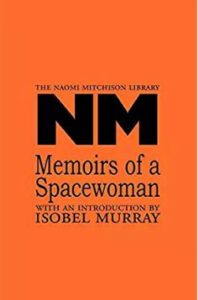 This is a genuinely strange novel from 1962, about a woman astronaut, a communications specialist, who travels in FTL craft to distant galaxies to study other life forms. Communicating with aliens is a problem of keen interest to me and why I bought the book. Unfortunately it is treated only superficially. Sometimes the narrator announces that “communication was accomplished” and other times, it wasn’t. No details. Still, the problematic is valid and interesting.
This is a genuinely strange novel from 1962, about a woman astronaut, a communications specialist, who travels in FTL craft to distant galaxies to study other life forms. Communicating with aliens is a problem of keen interest to me and why I bought the book. Unfortunately it is treated only superficially. Sometimes the narrator announces that “communication was accomplished” and other times, it wasn’t. No details. Still, the problematic is valid and interesting.
Most of the aliens encountered are insect-like: bugs, caterpillars, and butterflies, although there are some crustaceans, echinoderms, and even the rare mammalian creature. None are altogether alien, which is a problem in all sci-fi, trying to imagine a good alien. Lately, we seemed to have settled on the archetypal “grays,” the spindly-bodied, large-headed, big-eyed, nose-free ET of many movies, although squid are still in fashion. Insects and crustaceans are kind of alien-looking, especially if you don’t know anything about them, but there were no really well-imagined aliens here.
The book is anyway not really about that. I think it is a meditation on biology and time, sex and reproduction, and especially, on parenthood. The narrator explains that in her time (in the future), the purpose of sex is only reproduction, and the goal is for females to produce as much as possible. That seems like a harsh destiny from today’s point of view and I think there is an element of satire in the author’s presentation. I think she is very subtly asking the question, “What are we doing, ladies?”
Unfortunately for an astronaut who spends most of her life in suspended animation while flying through the galaxies, all her children on Earth live and die before she gets home, and that provokes a recurrent meditation on parenthood. What does it mean to have children if you only see them for a couple of hours of their life? Does giving birth automatically entail parenting? Again, an interesting meditation, presented here only very subtly, as would have been necessary for a woman in 1962.
The astronaut describes multiple adventures on multiple alien worlds, and no real danger comes up and there is little dramatic story tension. The narrative is just the astronaut’s report, written conversationally, as in a diary, about unconnected vignettes.
One long, overdrawn story is based on the old witticism that “caterpillars are skeptical of butterflies,” but in this case it is the reverse. The butterflies attack and kill caterpillars as inferior and reprehensible beings. The scientists are befuddled. Again, I wonder if the message is really about children and their parents. Communication with the butterflies is possible, but there are no grounds for discourse with them due to widely differing world views.
In the most interesting episode, the scientists find a life form that might not be sentient, whatever that might mean. But they discover that if a fragment of it is grafted onto another animal, the graft grows into a large, sentient being then detaches from the host. The astronaut volunteers to take a graft herself. She describes some very weird feelings, perhaps like being pregnant, or perhaps a parody of that. It is again a meditation on the meaning of reproduction and birth.
Overall, while slow in pace, lacking dramatic tension, repetitive, and somewhat hard to understand, this novel is sufficiently weird, and definitely counts as psi-fi, an exploration of human psychology in an alien context. Recommended for the thoughtful and persistent reader.
Mitchison, Naomi (1962/2011). Memoirs of a Spacewoman. Glasgow: Kennedy & Boyd, 176 pp.